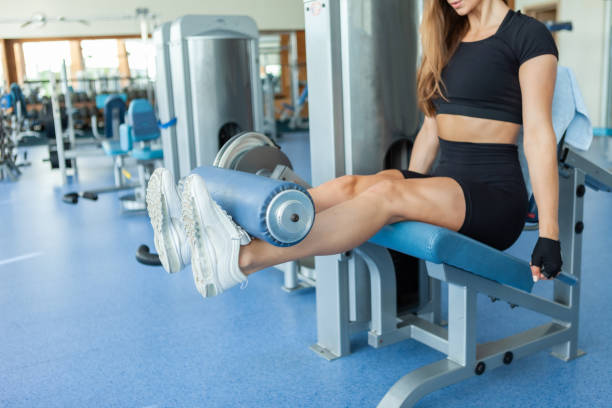Leg extensions are a staple in any leg workout routine, targeting the quadriceps muscles in the front of your thighs. In fact, leg extension machines are among the most used machines in 24 Hour Fitness.
In this guide, we will walk you through the correct technique for performing leg extensions and explore alternative variations to suit your fitness level and goals.
Executing Leg Extensions with Precision
To begin, set up the leg extension machine so that the padded bar rests on the top of your lower legs, just above the ankles, while your knees are positioned at a 90-degree angle. It’s crucial to choose a weight that provides a moderate load for 10 to 12 repetitions. Follow these steps to perform leg extensions correctly:
- Position yourself on the machine’s padded seat and place your hands on the hand bars for stability.
- Exhale and lift the weight, extending your legs until they are almost straight. Be mindful not to lock your knees and ensure your back remains against the backrest, avoiding any arching.
- Inhale and slowly lower the weight back to the starting position.
- Complete three sets of eight to 12 repetitions, allowing your muscles to experience the desired level of challenge.
The Advantages of Leg Extensions
Leg extensions effectively target the quadriceps, which play a significant role in activities such as walking, running, and kicking. Unlike closed chain kinetic exercises like squats, leg extensions are considered open chain kinetic exercises. In open chain exercises, the targeted body part is in motion rather than being anchored, as is the case with squats.
Cycling predominantly develops the quadriceps, while activities like running and walking tend to focus more on the hamstrings at the back of the thigh. If you engage in cardio activities that emphasize the hamstrings, it’s beneficial to balance your leg muscles by incorporating leg extensions into your routine. Strengthening the quadriceps can also enhance the force generated during kicking movements, offering advantages in sports such as soccer and martial arts.
Exploring Alternative Variations
If you don’t have access to a leg extension machine, don’t fret. There are alternative ways to perform leg extensions using ankle weights or resistance bands. Here are two variations:
Leg Extension with Ankle Weights
- Begin by sitting in a chair with proper posture.
- Lift one leg straight out in front of your body and hold for five seconds.
- Slowly lower your leg back to the starting position.
- Repeat the process with the other leg.
- This exercise can be performed with ankle weights ranging from 5 to 10 pounds or by looping a resistance band around your ankle and the rear leg of the chair on the same side.
Standing Resistance Band Leg Extension
- Attach one end of a resistance band behind you and loop the other end around your ankle.
- Stand in a position where the band has no tension when your knee is bent and your ankle is behind you. Use a rail or chair for balance if necessary.
- Slowly straighten your knee, causing tension in the band, while maintaining a straight back.
- Extend your leg as far as feels comfortable, pause momentarily, and then slowly return to the starting position.
- Complete 10 repetitions and repeat the process with the other leg.
It is also possible to perform a standing leg extension using a cable machine. Ensure you have an ankle cuff for this variation and use a light enough weight that allows you to fully contract your quadriceps at the top of the movement.
Common Mistakes to Avoid
To maximize the benefits of leg extensions and prevent strain or injury, steer clear of these common errors:
Heavy Lifting
Avoid attempting a maximum lift (1RM) on the leg extension machine, as this exercise is not suitable for low-rep, high-load strength conditioning. Pushing your limits in this manner may strain your knee ligaments.
Going Too Fast
Performing leg extensions rapidly utilizes momentum rather than engaging your muscles effectively. Momentum reduces the desired results and diminishes the isolation exercise’s effectiveness, as you end up recruiting other muscles to assist in completing the movement instead of targeting your quadriceps.
Locking the Knees
It is crucial not to lock your knees at full extension, especially if you are concerned about knee pain or strain. Locking your knees can place excessive strain on the knee joint. While fully contracting your quadriceps at the top, maintain a slight bend in your knees to alleviate potential strain.
Safety Measures and Precautions
If you have a knee, ankle, or thigh injury, it is essential to seek guidance from a medical professional, such as a doctor, a qualified physical therapist, or a strength and conditioning coach specializing in weight training rehabilitation. Depending on your specific condition, they may advise against using the leg extension machine.
Discontinue the leg extension exercise if you experience any pain in your knees or ankles.
Here’s a demo on how to use a leg extension machine:
